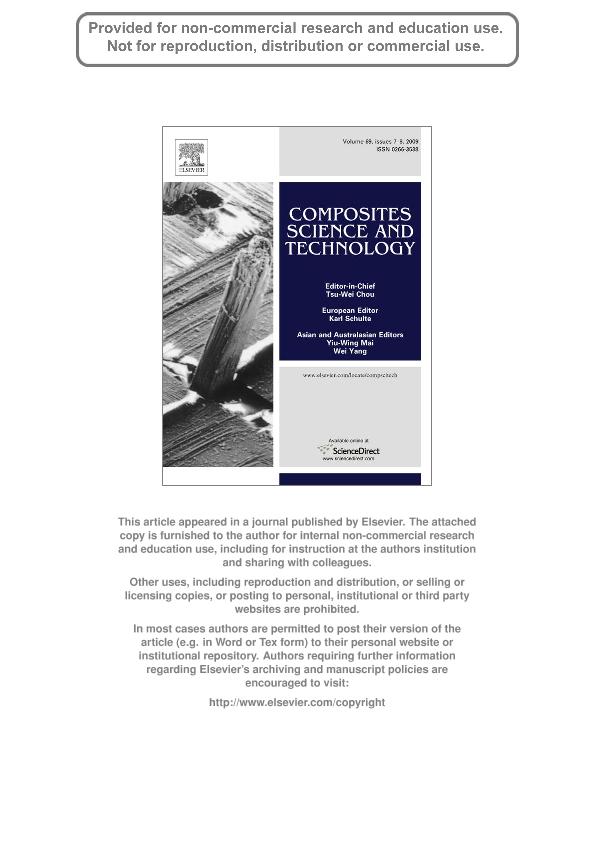Mostrar el registro sencillo del ítem
dc.contributor.author
Auad, Maria L.
dc.contributor.author
Mosiewicki, Mirna Alejandra

dc.contributor.author
Uzunpinar, Cihan
dc.contributor.author
Williams, Roberto Juan Jose

dc.date.available
2018-01-30T16:54:19Z
dc.date.issued
2009-07
dc.identifier.citation
Auad, Maria L.; Mosiewicki, Mirna Alejandra; Uzunpinar, Cihan; Williams, Roberto Juan Jose; Single-wall carbon nanotubes/epoxy elastomers exhibiting high damping capacity in an extended temperature range; Elsevier; Composite Science And Technology; 69; 7-8; 7-2009; 1088-1092
dc.identifier.issn
0266-3538
dc.identifier.uri
http://hdl.handle.net/11336/35012
dc.description.abstract
In nanocomposites containing single-wall or multi-wall carbon nanotubes (SWCNT and MWCNT) high damping can be achieved by taking advantage of the weak bonding and interfacial friction between individual nanotubes and the matrix. The increase in damping capacity has already been proved for stiff epoxies and in this study it is extended to epoxy elastomers. Variable amounts (0.5–3 wt%) of oxidized SWCNT were dispersed by ultrasonication in precursors of an epoxy elastomer based on the reaction of diglycidylether of bisphenol A (DGEBA) and a polyoxypropylene with average molar mass of 2000, end-capped with primary amine groups. The quality of the initial dispersion was assessed by the constancy of the storage modulus with frequency in the low-frequency range. A rheological percolation threshold of 0.41 wt% SWCNT was found. Cured elastomers exhibited a large increase of the loss modulus with increasing amounts of SWCNT. For 3 wt% SWCNT, the increase in loss modulus was 1400% at room temperature. When temperature was increased up to 140 °C the loss modulus of the nanocomposite was practically constant while the one of the matrix dropped to a negligible value. The damping capacity at high temperatures opens important practical applications.
dc.format
application/pdf
dc.language.iso
eng
dc.publisher
Elsevier

dc.rights
info:eu-repo/semantics/openAccess
dc.rights.uri
https://creativecommons.org/licenses/by-nc-sa/2.5/ar/
dc.subject
A. Carbon Nanotubes
dc.subject
A. Nanocomposites
dc.subject
A. Functional Composites
dc.subject
B. Mechanical Properties
dc.subject
B. Interfacial Strength
dc.subject.classification
Nano-materiales

dc.subject.classification
Nanotecnología

dc.subject.classification
INGENIERÍAS Y TECNOLOGÍAS

dc.title
Single-wall carbon nanotubes/epoxy elastomers exhibiting high damping capacity in an extended temperature range
dc.type
info:eu-repo/semantics/article
dc.type
info:ar-repo/semantics/artículo
dc.type
info:eu-repo/semantics/publishedVersion
dc.date.updated
2018-01-25T19:53:33Z
dc.journal.volume
69
dc.journal.number
7-8
dc.journal.pagination
1088-1092
dc.journal.pais
Países Bajos

dc.journal.ciudad
Amsterdam
dc.description.fil
Fil: Auad, Maria L.. Auburn University; Estados Unidos
dc.description.fil
Fil: Mosiewicki, Mirna Alejandra. Consejo Nacional de Investigaciones Científicas y Técnicas. Centro Científico Tecnológico Conicet - Mar del Plata. Instituto de Investigaciones en Ciencia y Tecnología de Materiales. Universidad Nacional de Mar del Plata. Facultad de Ingeniería. Instituto de Investigaciones en Ciencia y Tecnología de Materiales; Argentina. Auburn University; Estados Unidos
dc.description.fil
Fil: Uzunpinar, Cihan. Auburn University; Estados Unidos
dc.description.fil
Fil: Williams, Roberto Juan Jose. Consejo Nacional de Investigaciones Científicas y Técnicas. Centro Científico Tecnológico Conicet - Mar del Plata. Instituto de Investigaciones en Ciencia y Tecnología de Materiales. Universidad Nacional de Mar del Plata. Facultad de Ingeniería. Instituto de Investigaciones en Ciencia y Tecnología de Materiales; Argentina
dc.journal.title
Composite Science And Technology

dc.relation.alternativeid
info:eu-repo/semantics/altIdentifier/doi/http://dx.doi.org/10.1016/j.compscitech.2009.01.030
dc.relation.alternativeid
info:eu-repo/semantics/altIdentifier/url/https://www.sciencedirect.com/science/article/pii/S0266353809000335
Archivos asociados
